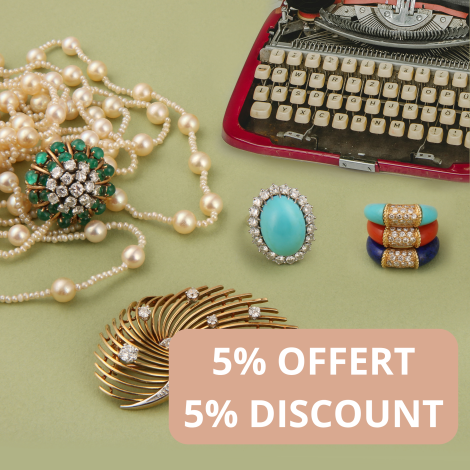Jewelry of the 40s and 50s

Jewellery from the 1940s and 1950s contrasts sharply with the Art Deco style. Gone are the strict black and white tones of platinum and diamonds! Hello to sparkling yellow gold, coloured stones and large shapes that tell the story of a time when people were getting back on their feet and hope was reborn. This retro period, which began during the war and exploded after the Liberation, remains one of the most stunning in the history of jewellery. At Les Pierres de Julie, in the heart of the Swiss Village in Paris, we showcase these vintage gems to passionate collectors every day.
Jewellery from the 1940s and 1950s: a style that changed everything

rose and yellow gold Brooch set with diamonds, circa 1940-1950
Yellow gold is becoming the top choice. After years of cold platinum, this warm metal is making a comeback. But be careful, not just any gold! Jewelers of the era added copper to their mixtures, giving the gold in jewellery from the 1940s and 1950s its distinctive, slightly pinkish colour. This typical hue, sometimes almost red, still makes it easy to tell at a glance whether a piece of jewellery dates from that period.
The Tank ring, the star of its era

Bague Tank, Or Jaune, Diamants, Rubis Synthétiques, Circa 1940-1950
One cannot discuss retro jewellery without mentioning the famous Tank ring. Its name? It owes it to the tanks of the Second World War. Surprising, isn't it? A symbol of war that has become a beautiful object. These large rings with architectural shapes are still among the most sought-after vintage jewellery items today. Their links are reminiscent of tank tracks, but with incredible class. Yellow gold is often combined with platinum or white gold to make it stand out. The Tank ring remains the most famous piece of retro jewellery.
Animals in jewellery, full of meaning
Animal brooches become messages. In 1942, Cartier created a cage brooch with a sparrow inside to symbolise the occupation. Years later, it recreated this model, but this time the cage was open and the bird was ready to fly away, to celebrate liberation in 1944. Cartier made a big impact with these creations that spoke to people. And what about the first Panthère ring created by Jeanne Toussaint in 1943? A fashion that changed everything and still endures today.

Cartier Panther Ring
Materials used for retro jewellery: the art of making do with what you have
War imposes limitations. Platinum? The army takes it. Precious stones from Asia? The roads are cut off. Jewellers at the time were extremely creative in finding solutions.
The supply of precious stones from Asia was also cut off. That is why jewellery from the 1940s mainly features sapphires or rubies made in laboratories using the Verneuil process. Auguste Verneuil invented this technique in 1902, but it really took off during the war. These stones have very distinctive colours: a strong pink for rubies and a deep blue for sapphires. Today, these colours help to identify jewellery from this period.
Ideas for replacing what is missing
Jewellers are full of ideas. Old jewellery is often remelted. It is taken apart, salvaged and transformed. Victorian jewellery is remade to suit contemporary tastes. Very thin gold leaf gives the impression of beautiful jewellery without using too much precious metal. Brazil and Colombia are becoming the new suppliers of stones: amethysts, citrines, aquamarines, tourmalines. A rainbow replaces the black and white of Art Deco.
How to spot vintage jewellery from the 1950s

Yellow gold ring with Verneuil synthetic rubies and sapphires and emeralds, circa 1940–1950.
You need a keen eye to recognise a genuine piece of jewellery from the 1940s and 1950s. Here are some tell-tale signs:
- Rose gold: this warm, almost red hue, thanks to the addition of copper
- Large, asymmetrical shapes: gone is the perfect symmetry of Art Deco.
- Verneuil synthetic stones
- Tubogas mesh: this thick, round mesh is typical of the period.
- Secret watches: watches concealed beneath a decorated cover
- Drawings of flowers and animals: butterflies, birds, panthers... nature is everywhere.
- The absence of dates: many jewellers did not date their creations during the occupation.

Bracelet made of Tubogas mesh, circa 1940–1950
Post-war jewellery inspirations
After the war, creativity exploded. Women wanted to shine and forget the dark years. Hollywood was a great source of ideas. Actresses wore incredible jewellery that everyone dreamed of. Rita Hayworth, Marlene Dietrich, Joan Crawford... They set the trends.

Marlene Dietrich wearing a Van Cleef & Arpels bracelet
The 1950s were inspired by nature: flowers, leaves, flying animals (birds, butterflies, insects), frogs, snakes. The sea was also a source of ideas, with starfish, seahorses, fish and shells. Themes became more abstract towards the end of the 1950s, influenced by new artists. Jewellery became sculpture.
The great fashion houses of the era and their star jewellery pieces
How to properly care for retro jewellery from the 1940s and 1950s
These vintage jewellery pieces deserve to be treated with care. Their age and materials require careful handling. Antique jewellery with rare stones can be more fragile than newer pieces.

A Secret Watch Boucheron, circa 1940
For rose gold typical of the period, strong chemicals should be avoided at all costs. Simply clean with warm water and soap, then dry thoroughly with a soft cloth. Verneuil synthetic stones are strong but do not like changes in temperature.
Tips for keeping your vintage jewellery in good condition
Storage is very important. It is best to keep them in a fabric-lined box or silk bag, and if possible, wear them from time to time so that they benefit from the natural moisture of the skin. Jewellery should always be separated to avoid scratches. Tank rings, which are large, need separate compartments.
For secret watches, have the mechanism checked regularly by a watchmaker who is familiar with vintage jewellery.
Where to find vintage post-war jewellery
There are plenty of places in Paris where you can find these treasures. The Swiss Village, where our shop Les Pierres de Julie is located, is a must-see.
The influences of 1950s jewellery design
In the 1950s, the world was changing rapidly. In 1948, the largest diamond company, De Beers Diamond Corporation, launched the slogan ‘A diamond is forever’. This superb campaign revived the diamond market. Women wanted engagement rings, pearl necklaces and complete sets.
American influence is growing. American soldiers are returning from Europe with jewellery for their wives. Cultural exchanges are increasing. Italian style is beginning to dominate with Bulgari. Jewellery is becoming international.
Frequently asked questions about retro jewellery from the 1940s and 1950s
How can you tell exactly what year a piece of jewellery from the 1940s or 1950s dates from ?
The colour of the gold, the type of stones, and the techniques used to set them provide clues. Hallmarks, when present, are the best indication.
What are the differences in style between jewellery from the 1940s and jewellery from the 1950s ?
The 1940s favoured architectural and geometric forms such as Art Deco. The 1950s turned towards nature and abstraction.
How can you care for vintage jewellery without damaging it ?
Lukewarm water, mild soap, careful drying. Avoid ultrasonic cleaning for old synthetic stones. Use a professional for complicated jewellery.
For a free valuation of your vintage jewellery, Les Pierres de Julie welcomes you to its shop in the Village Suisse, just a stone's throw from the Eiffel Tower. You can also send an email with your photos to contact@lespierresdejulie.com.Our passionate experts will be able to recognise and value your jewellery.
Nouveautés
- 4.200 €
- 4.200 €
- Unit price
- / per
- 4.950 €
- 4.950 €
- Unit price
- / per
- 3.950 €
- 3.950 €
- Unit price
- / per
- 3.800 €
11.450 €- 3.800 €
- Unit price
- / per











